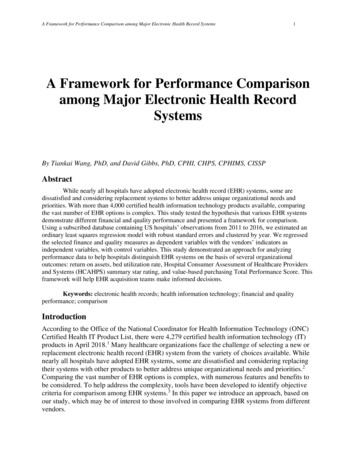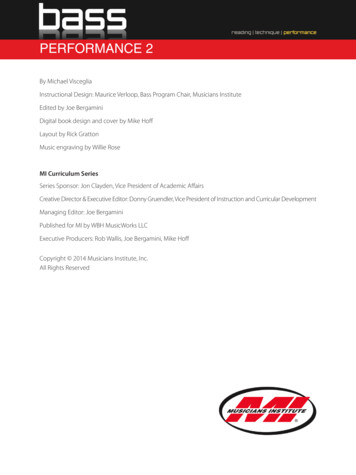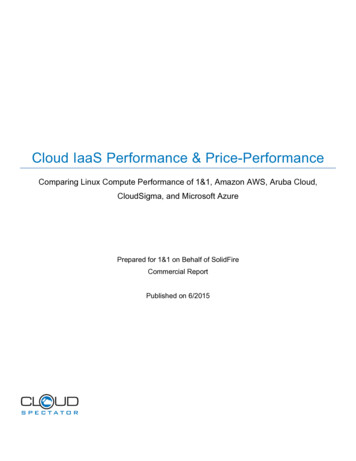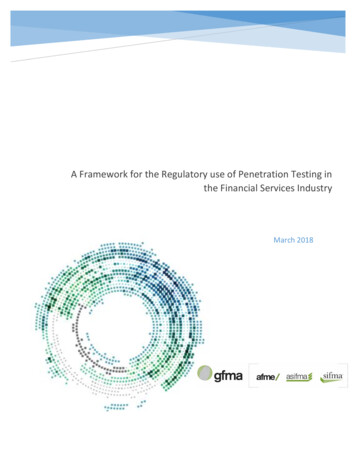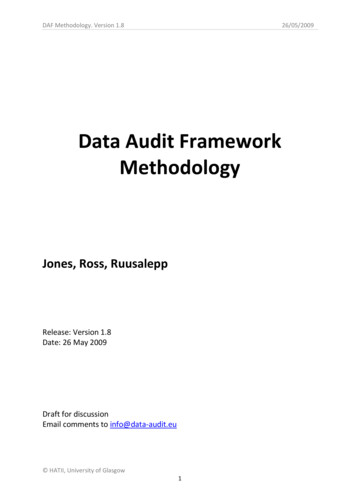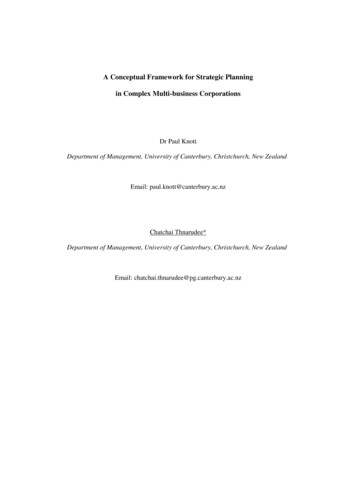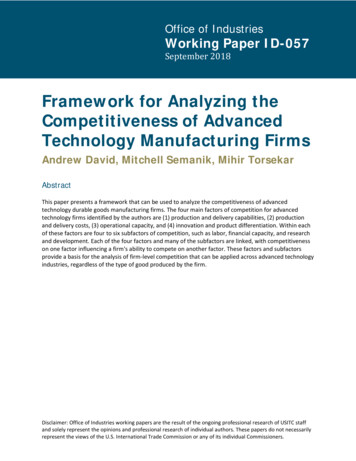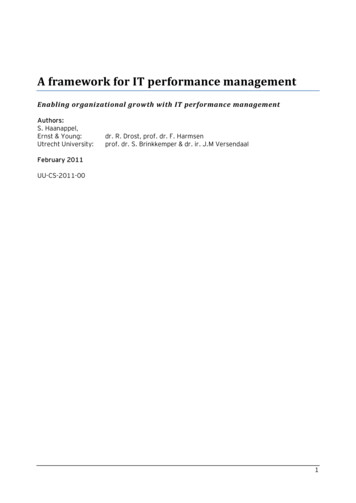
Transcription
A framework for IT performance managementEnabling organizational growth with IT performance managementAuthors:S. Haanappel,Ernst & Young:Utrecht University:dr. R. Drost, prof. dr. F. Harmsenprof. dr. S. Brinkkemper & dr. ir. J.M VersendaalFebruary 2011UU-CS-2011-001
ISSN: UU-CS-2011-00Address:Dept. of Information and Computing SciencesUtrecht UniversityP.O. Box 80.0893508 TB UtrechtThe Netherlands2
A framework for IT performance managementEnabling organizational growth with IT performance managementAuthors:S. Haanappel,Ernst & Young:Utrecht University:dr. R. Drost, prof. dr. F. Harmsenprof. dr. S. Brinkkemper & dr. ir. J.M VersendaalAbstractThis research provides insight into how organizations can achieve and optimize the benefits ofIT performance management. The relevance of this research is the importance fororganizations to achieve value from their investments and that there is little scientificliterature available guiding them how to do this. To achieve value from investments a focus onIT performance management is required that takes care of the removal of non value-addingactivities and processes.IT performance management can be defined as the area of setting goals, responsibilityaccounting and monitoring/ analyzing/ governing and improving the performance of IT.Benefits of IT performance management are that a focus on the realization of strategic,financial and non-financial goals is applied and that KPIs are made explicit and measurable. ITperformance management requires effective IT management to meet business objectives. Andan IT performance measurement process needs to be selected. Performance measurementframeworks need to be balanced, multidimensional, comprehensive and integrated into theorganizational performance measurement framework. Performance measurementframeworks include metrics and a budgeting approach. Performance metrics are used togovern measures and need to match the goals of the organization. When they are not wellimplemented the planning and control of these metrics is impeded. The goals of budgetingsystem development are the development and maintenance of a process for the planning andmanagement of activities. These activities are deducted from the strategic and tactical plansand the corresponding benefits and costs are translated into a financially formulated plan.In addition to a literature research that provided insight into what has been written about ITperformance management a case study research was conducted. In this case study researchorganizations participated to provide insight into their IT performance management approach.Additionally their approaches were compared to determine their IT performance managementmaturity.The results showed that the organizations had very different IT performance managementapproaches and maturity levels. The majority of organizations did not seem to use theirperformance results when developing IT performance management plans for the next year.3
However several of the organizations tried to create commitment by making their employeesresponsible for key performance indicators. In general it could be said that organizations werenot aware that their IT performance results could be used to improve IT performancemanagement and/or they did not know how to do this, as it has not been done and there areno guidelines available. Based on the dataset gather during this research it can be said thatthe organizations are not mature enough to optimize their IT performance managementbenefits, as they have not yet been able to develop a loop back into the IT performancemanagement cycle to use the results to their benefit.4
Chapter 1 – IT performance managementTable of ContentsAbstract3Chapter 1 – IT performance management81Introduction82The objectives of IT performance management933.1IT governanceCobit12134Balanced scorecard1455.15.2Metrics, standards and budgetingMetrics & standardsBudgeting1717186Cost allocation and shared service centers19Chapter 2 – Research method and protocol221Introduction2222.12.22.3Case study researchChoosing the research methodAn introduction to case study researchAdvantages and disadvantages of case study research2323232433.13.2Research approachResearch questionsResearch plan24242544.14.24.34.44.54.64.7Case study protocol for IT performance management approachGetting startedCase study protocol roadmap for this researchCase selectionCollecting dataAnalyzing dataPlan validityRounding up2626293030303232Chapter 3 – The IT performance maturity model335
Chapter 1 – IT performance management11.1IT performance maturity modelFramework construction1.1.1Characteristics of IT performance management1.1.2Characteristics of IT performance measurement1.1.3Characteristics of cost allocation1.2Application of the framework on Company C and Company E1.2.1Company C1.2.2Company E333334343536363922.1IT performance maturity modelIT performance maturity model applied on the organizations2.1.1IT performance maturity model per organization2.1.2IT performance maturity model overview2.2Framework analysis2.2.1Company A2.2.2Company B2.2.3Company C2.2.4Company D2.2.5Company E2.2.6Company F414243444849495050515233.13.2535354544Modeling the IT performance management constructionMetamodelIT performance management method3.2.1Description of the methodComparing the method to ITPM characteristics from literatureChapter 4 – Research questions and discussion &future research585955.15.25.35.45.5Research questions59What are the business benefits that IT performance management delivers?59Which Key Performance Indicators are used, why and what are the results?60How are these KPIs used to govern the organization?60How are the IT costs allocated to the business?60How do companies achieve and optimize the benefits of IT performance management?616Discussion617Future research62Literature63Annex 1 – Planning overview696
Chapter 1 – IT performance managementAnnex 2: One pager70Annex 3: Questionnaire IT Controller71Annex 4: Questionnaire CIO72Annex 5: Frameworks organization A, B, D and F737
Chapter 1 – IT performance managementChapter 1 – IT performance management1IntroductionFor organizations it is crucial to receive value for every euro they invest on. This requires afocus on performance management and the removal of non value-adding activities andprocesses. As the amount of scientific literature available on IT performance management islimited, a definition of IT performance management has been developed by my supervisors forthis research. Therefore the definition used during this research is:“IT Performance Management can be defined as the area of setting goals, responsibilityaccounting and monitoring/ analyzing/ governing and improving the performance of IT.”IT performance management is often an aspect of achieving organizational and strategic goalsand also a critical aspect of organizational controls (Kang, Bradley, 2002). However ITinvestments frequently result in unexpected, uncertain and undesired results (VanGrembergen, Van Bruggen, 1997; Turban, McLean, Wetherbe, 2001; Tuten, 2009,Strassman, 1997; Car, 2004). Therefore appropriate measures are required in order toidentify and create metrics for measuring the contribution of IT to the organization‟s valuechain (Lomerson and Tuten, 2005).According to Seddon, Graeser and Willcocks (2002) the amounts spend on IT indicate thatorganizations are capable of identifying which forms of IT expenditure and management aremost effective. De Boer (2002) adds to this notion that the management and control of IT isalso critical as organizational incomes are under pressure. Evaluating IT investments enables anatural learning process for the organization (Remenyi et al., 2000). Measuring IT results fororganizations is complicated as some of the benefits are intangible (Finding, 2004). However,the return on investment is more relevant than before (Dekkers, 2004). The difficulty withmeasuring IT performance has lead to an increase in the evaluation and assessment of ITinvestments (Remenyi, Money and Sherwood-Smith, 2000).For IT to be successful in delivering against business requirements, management should putan internal control system or framework into place (IT Governance Institute, 2007). Beingserious about implementing IT performance management let organizations to becomeproactive instead of reactive and chasing non-measurable and sometimes opportunistic ITgoals (De Boer, 2002; Lagsten and Goldkuhl, 2008). It also contributes to the creation ofvalue for the company and realizing business cases. Organizations adopt IT performancemanagement in order to achieve specific objectives such as reducing expenses and creating acompetitive advantage (Lomerson, Tuten, 2005).The need for organizations to achieve value on their investments and to become proactiverequires research in the area of IT performance management. Providing insight into howorganizations can benefit from IT performance management responds to the changesorganizations face. During this research the scope will be limited to the utility sector, as it hasbeen subject to change and it may lead to interesting findings on the application of ITperformance management.8
Chapter 1 – IT performance managementThe main research question of this research is:“How do companies achieve and optimize the benefits of IT Performance Management?”To answer the main question four additional sub-questions need to be answered:1.Which Key Performance Indicators are used, why, and what are the results?2.How is the IT Performance governed?3.How are the IT costs allocated to the business?4.What are the results (tangible/intangible) that IT Performance Management delivers to acompany?The social and scientific relevance of this research is based on the fact that the area of ITperformance management is relatively unexplored. A small amount of literature is available,which makes it difficult to develop an understanding of IT performance management and howan organization can apply it to its benefit. Guidelines on how to achieve advantages of ITperformance management seem to be unavailable, even though they could be of great value.The results of this research could be used by organizations who want to use their ITperformance results in order to become proactive and improve their IT performancemanagement.2The objectives of IT performance managementIn the context of developing IT performance evaluation methods, researchers have developeda stream of tools, measures and techniques (Tuten, 2009; Renkema, 2000). But performancemeasures are rarely integrated or aligned with business processes, even though ITperformance management requires insight in the functioning of processes and needs to usethe performance results to increase performance (De Boer, 2002; Neely 1999). Achievinginsight can be difficult as performance management measurements are often intertwined.Having a set of operationally-based objectives generally makes the evaluation process morestraightforward (Remenyi et al., 2000). Process assessment enables the organization todetermine the value of an innovation/investment (Remenyi et al., 2002; Brynjolfsson, Hitt,1995; Barua et al, 1995, McKeen et al., 1999; Mooney et al., 1995 ; Vernet et al., 1996). Byapplying IT performance management, the vision and strategy of an organization aretranslated into concrete goals and organized based on four points of view: financial, customer,internal organization and learning, and growth abilities of the organization (De Boer, 2002). Inorder for an organization to gain advantage from IT performance management, it should beexecuted through planning and control, metrics and measurements, KPIs, financial indicatorsand service levels (Wiggers, De Boer-de Wit and Kok,2004). Simonson and Johnson (2006)provide additional characteristics to achieve organizational value, such as costing, directingand decision-making concerning the implementation, and use of IT resources within a firm.Andra (2006) defines four areas for which IT performance management is needed. The firstarea is about connecting IT to the bottom line of the organization. The level of performance isthen demonstrated by the ability to present and communicate the value that IT services bringto the company‟s bottom line. Second, IT performance management is needed for business ITalignment. IT needs to be involved in activities that match and support the goals from the9
Chapter 1 – IT performance managementbusiness plan. Third and fourth, IT performance management is needed for IT efficiency andeffectiveness. Some advantages of IT performance management are (De Boer, 2002): Applying a focus on the realization of strategic, financial and non-financial goals Making KPIs explicit and measurable The management of prognosis and action oriented reports The availability of consistent management information on strategic, tactical andoperational level (drill down) Using the results as a guideline for intra organizational communication Fostering a result-oriented culture/climate The possibility to benchmark the organizationWhen an organization determines to start measuring performance, it could use a PerformanceManagement System or PMS. A PMS tracks the actual performance of an organization, helpsto identify weaknesses and supports communication and decision-making processes. The mostimportant objective of performance measurement is to replace intuition by facts. The aim of aPMS is to evaluate the success of a system‟s implementation and to continuously improve theperformance of the system being measured (Wettstein, Kuen, 2002).Strategy implementationOrganizations rely on IT for success, both for operational and strategic aspects (Andra, 2006).Effective IT management is required to meet business objectives, both on the operational andbusiness side of IT. IT performance results require actions, because without appropriateresponse, measurement is useless (Andra, 2006). However, only a small percentage of ITprojects are evaluated (Hallikainen et al., 2006). Examples of performance metrics used todetermine the performance of IT and business functions are presented in figure 1 (Andra,2006).IT metricsCapital/operations budget performanceOperations/business function metricsCustomer satisfaction indicatorsReturn on investmentResource allocation/usageReturn on investmentTotal Cost of OwnershipResponse timeMaintenance costsService-level performanceApplication performanceNumber of errorsFigure 1 Examples of performance metrics-The performance metrics that organizations apply are based on the organization‟s current ITstrategy and can anticipate on future goals (Andra, 2006). The type of value center, i.e. howthe IT department is seen by the organization, influences the development of metrics. Theterm value center is introduced by Venkatraman (1997) and differentiates organizationsbased on their IT goals. It recognizes the role of IT as part of the business operations, the socalled value orientation for IT (Venkatraman, 1998). The concept of a value center iscomposed of four interdependent centers, see figure 2(Venkatraman, 1998). For a moreelaborate explanation on the types of value center refer to the paper of Venkatraman “Notfixing technical bugs but creating business value” (Venkatraman, 1998).10
Chapter 1 – IT performance managementCost centerService center Reflects an operational focusthat minimizes risk with adominant focus on operationalefficiency While still minimizing risk, aimsto create IT-enabled businesscapability to support currentstrategiesType ofvalue centerInvestment centerProfit center Has a longer-term focus andaims to create new IT-basedbusiness capabilities To deliver IT services to themarket for incremental revenueand gain learning andexperienceFigure 2 Types of service centersAccording to Sward (2006), IT often loses its significance as a major contributing successfactor to the organization‟s strategic objectives. This happens because it is predominantlyconsidered as a non-integral aspect on the process of achieving business objectives.Consequently budgets are squeezed yearly, shifting IT organizations toward the cost centerview and making it hard to enable a long-term competitive advantage. But IT managementshould not be seen in isolation, as it disallows IT to show the profitability of the company itsupports. Some reasons for IT performance measurement are (Finding, 2004):Establish the progress toward achieving our goalsDocument organizational IT achievementsSecure financial and other resourcesIdentify internal improvement opportunitiesImprove communication with usersIT performance measurementThe selection process of a performance measure is crucial. It requires explicit communicationabout performance priorities and the relationships between the priorities to reveal hiddendifferences in the state of mind of stakeholders (Neely et al., 2000). There are severalrequirements to performance methods (Finding, 2004) like reliability, consistency, directconnection to important goals, understandability and that they need to be easilycommunicated. Measures also need to be agile and developed while being clear who isresponsible for the measure and what actions are taken on the results of the measure.Performance measurement frameworks need to be balanced, multidimensional,comprehensive and integrated into the organizational performance measurement framework(Jack, 2002). They should not exist in isolation of performance management techniques andimprovement initiatives, but reflect the requirements and goals of the organization (Ballantineand Brignall, 1994 referred to by Jack, 2002). It is this interface between measurement,management and leadership that is crucial in ensuring that performance measures drive valuecreation (Jack, 2002). Methods for IT measurement can be categorized into two groups; thefinancial and the organization-based methods (Neely, 2009). Financial measures are11
Chapter 1 – IT performance managementtraditionally used to determine the value of IT investments (De Boer, 2002). However it isimpossible to capture all types of added value in financial indicators (Martinsons, 2000;Coleman, 1995; Avram, 2001). Instead of just using financial data, non-financial measuresconsent to a wider perspective on results achieved and increase the value accuracy (Read,2009; Eccles, 1991) Additional non-financial measures are also better when identifyingupcoming trends and possible future results (Andra, 2006). Some reasons why financialmeasures are not the best solution anymore are:Financial measures encourage short-terminism, for example delay of capital investment(Banks, Wheelright, 1979; Hayes and Abernathy, 1980)Financial measures lack strategic focus and fail to provide data on quality,responsiveness and flexibility (Skinner, 1974)Financial measures encourage managers to minimize the variances from standard ratherthan seek to improve continually (Schmenner, 1988; Turney, Anderson, 1989)They fail to provide information on what customers want and how competitors areperforming (Neely, 1999).In addition, traditional financial measures provide no standards for reporting on IT costs,which decreases transparency (Read, 2009). Transparency in investments shows if goals havebeen met. As budgets are based on for example the previous year‟s percentage of sales orcost, the inability to measure IT value creates problems during the development oforganizational budgets (Read, 2009). However the implementation of performance measuresneeds guidance and should take into consideration the potential impact and consequences(Jack, 2002). Measurement-managed organizations are described as organizations who haveadopted a strategic and balanced set of KPIs which they use to plan, implement, operate andmonitor the strategies, functions and processes of their organization with (ITPMG, 2006).3IT governanceIT governance decision-making is mostly strategic oriented, therefore tactical decisionsreceive less
5.2 Which Key Performance Indicators are used, why and what are the results? 60 5.3 How are these KPIs used to govern the organization? 60 5.4 How are the IT costs allocated to the business? 60 5.5 How do companies achieve and optimize the benefits of IT performance manageme

